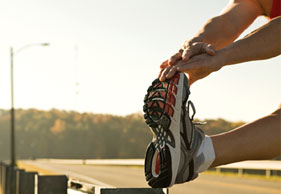It seems that stretching has always been part of sport, a routine that many of us probably do without even thinking about it because we’ve been doing it for years, and everyone does it… But most of us do it all wrong, and this often leads to injury.
Go on, admit it, you’ve done it as well. You’ve stood there before a run, stretching every leg muscle you can find, trying to touch your toes, pulling your feet towards your head like a contortionist, all in the vain hope of warming up for the run – when in fact, you’re doing exactly the opposite!
So says Benita De Witt, renowned physiotherapist and sports therapist from Somerset West in the Cape. “For years nobody questioned the theory and told sportspeople to stretch as part of their warm-up, but I found through experience that stretching was to blame for many injuries.” “You’d be amazed how many people are against stretching these days. A lot of physio’s are now telling their patients not to stretch, or only to do a limited amount after their run or sporting activity.”
Tight Spot
Benita likens the muscles to an elastic band when she explains to her patients why their stretching is causing them to pick up injuries. “If you have a piece of elastic that should be 15cm long but is only 10cm long because there is a knot in it, and you then stretch it up to 15cm, you still have the knot – and two pieces of overstretched, strained elastic on either side. That is what happens when you have a tight spot in your muscle: you end up overstretching the muscle on either side of the tight spot, whereas the area that actually needs stretching remains tight.”
She adds that at least 80% of injuries occur in muscles that are too long and overstretched, nearly always in the overstretched parts and in the areas where the overstretched parts connect to the tightness. So, Benita says the safest thing to do is to find a massage therapist to release the tightness, or use a foam roller to release it yourself, and then use active dynamic short stretches after training to maintain the correct length of the muscle and prevent it from tightening up again.
The Right Stretches
Benita says that the main stretches that one should do must be on the power muscles on the outer side of the leg, which do most of the work and which tend to shorten. The stabilising muscles on the inner side tend to be much weaker, tend to lengthen and overstretch, and therefore should not be stretched – but that’s what most runners stretch all the time. “Nothing on the inside of leg should be stretched. No groin, inner quad, inner calf – you should only be stretching the outside of the leg,” she says.
That’s why most of the stretches that athletes do in general are actually bad for them. “First there is the good old calf stretch – pushing over the wall – which overstretches the inside of the calf, a stabiliser. Another is the straight leg hammie stretch – touching your toes – which stretches the inside hamstring, another stabiliser. A third one is the groin stretch, working the adductors on the inside of the leg, which are normally the weakest muscles in athletes I test. All this overstretching of the inner leg leads to you losing stability in your knee, and that leads to injury,” warns Benita.
The Right Timing
Another thing that people misunderstand is that they think stretching is a warm-up, or should be done as part of a warm-up routine. It’s actually the opposite, say Benita. “To warm-up means moving the muscles quickly to activate them, whereas stretching opens the muscles and allows them to cool down. If you want to start running, you need to activate your muscles. Stretching actually de-activates the muscles, so it should be done only after running and a cool-down.”
Also, one shouldn’t stretch a muscle for 20 seconds, just two seconds, because 20 will overstretch it. “You’ll lose the tone of the muscle by hanging on it for that long. All you want to do in a stretch is maintain length.”
Coming next month:
Get the April edition of Modern Athlete for our definitive guide to stretching, including the best stretches for runners, and the right way and wrong way to stretch.


